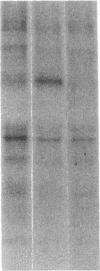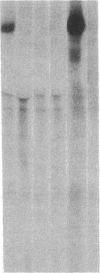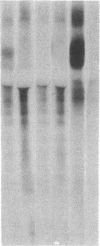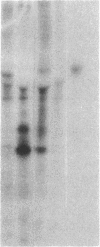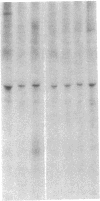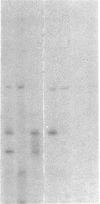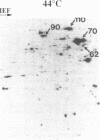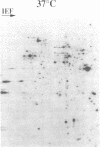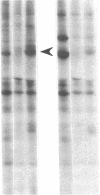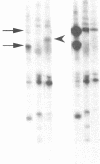Abstract
Patients with insulin-dependent diabetes (IDDM) possess antibodies to islet proteins of M(r)-64,000. Potential autoantigens of this M(r) include glutamate decarboxylase (GAD) and 65 kD heat shock protein. We have detected two distinct antibody specificities in IDDM that bind 50,000 M(r) or 37,000/40,000 M(r) proteolytic fragments of 64,000 M(r) proteins. In this study, we investigated relationships of these proteolytic fragments to GAD and heat shock proteins. Polyclonal antibodies to GAD bound 50,000 M(r) fragments of islet antigen. Recombinant GAD65, but not GAD67, blocked binding to this antigen, suggesting that 50,000 M(r) fragments are derived from islet GAD65. In contrast, GAD antibodies did not recognize 37,000/40,000 M(r) fragments, and neither GAD isoforms blocked autoantibody binding to precursors of these fragments. The 37,000/40,000 M(r) fragments, but not the 50,000 M(r) fragments, were detected after trypsin treatment of immunoprecipitates from insulinoma cells that lacked expression of major GAD isoforms. Antibodies in IDDM did not bind native or trypsinized islet heat shock proteins. Thus, IDDM patients possess antibodies to GAD, but also distinct antibodies to a 64,000 M(r) protein that is not related to known GAD isoforms or heat shock proteins.
Full text
PDF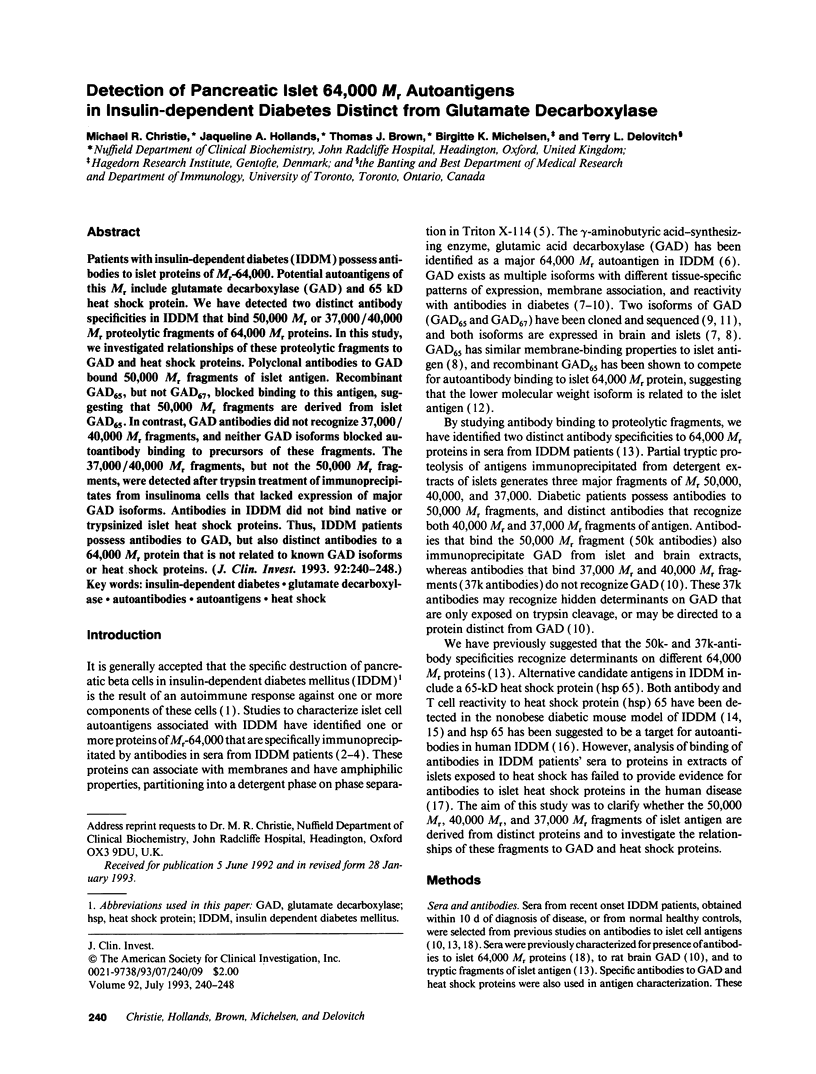
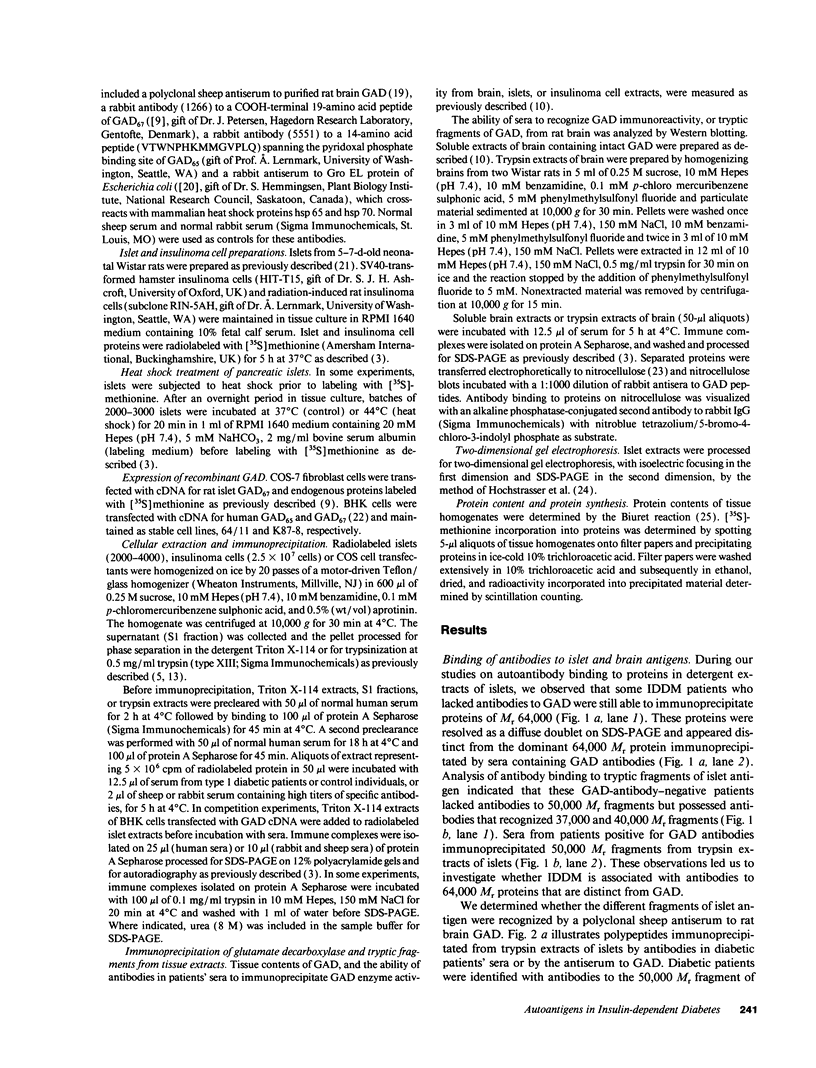
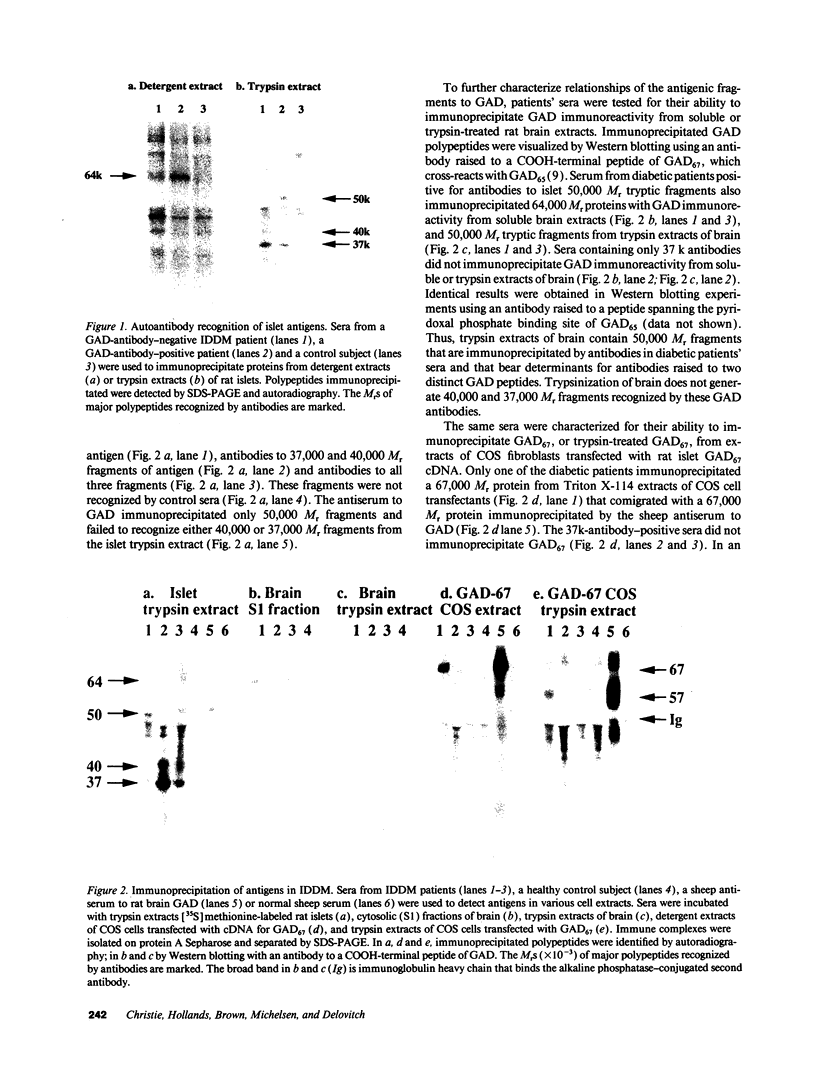
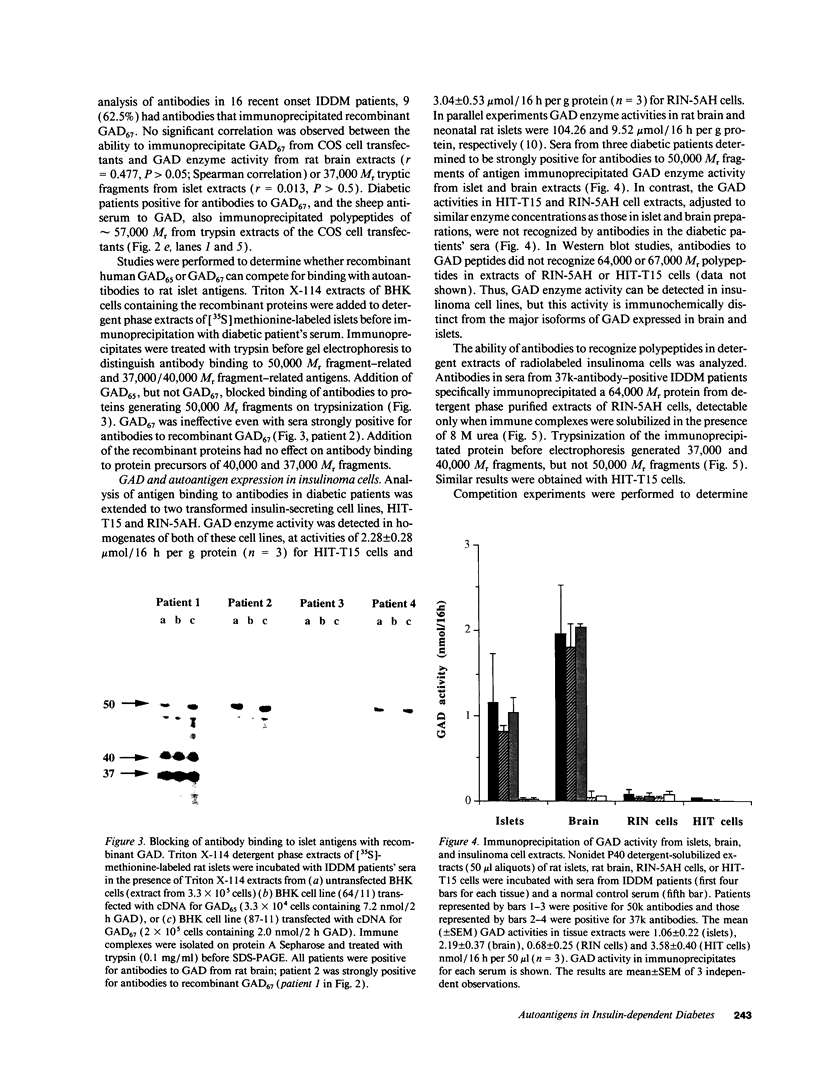
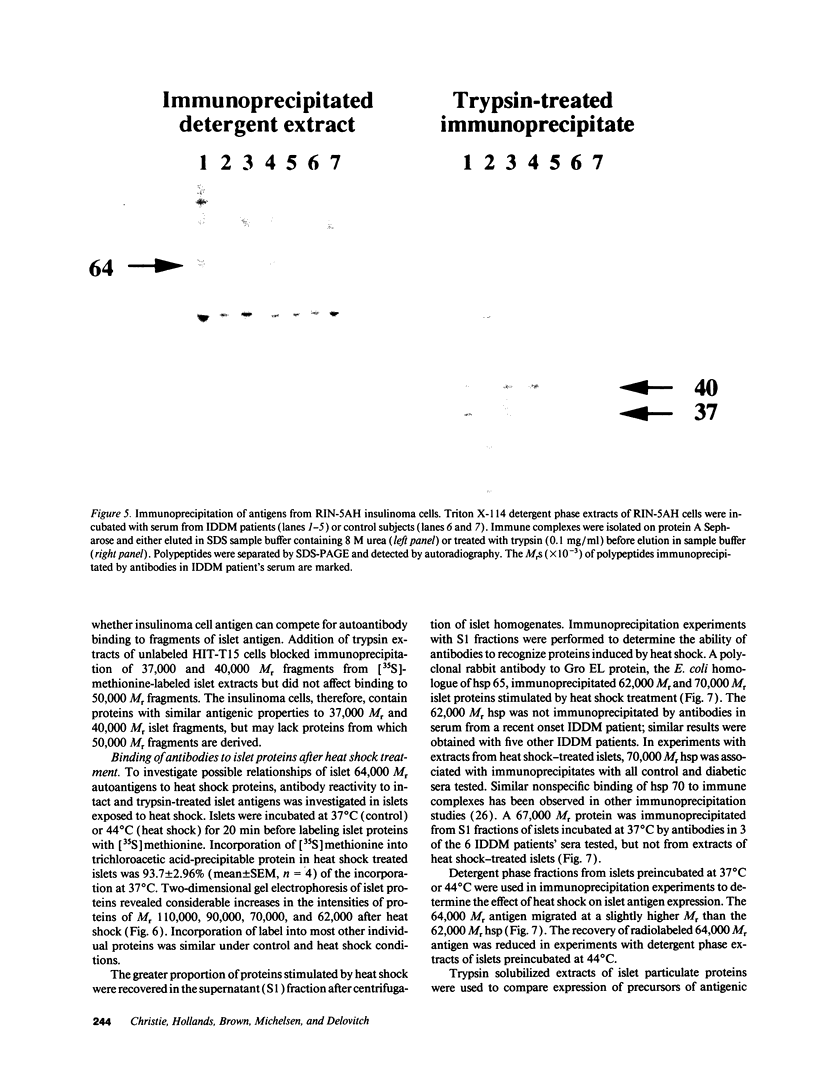
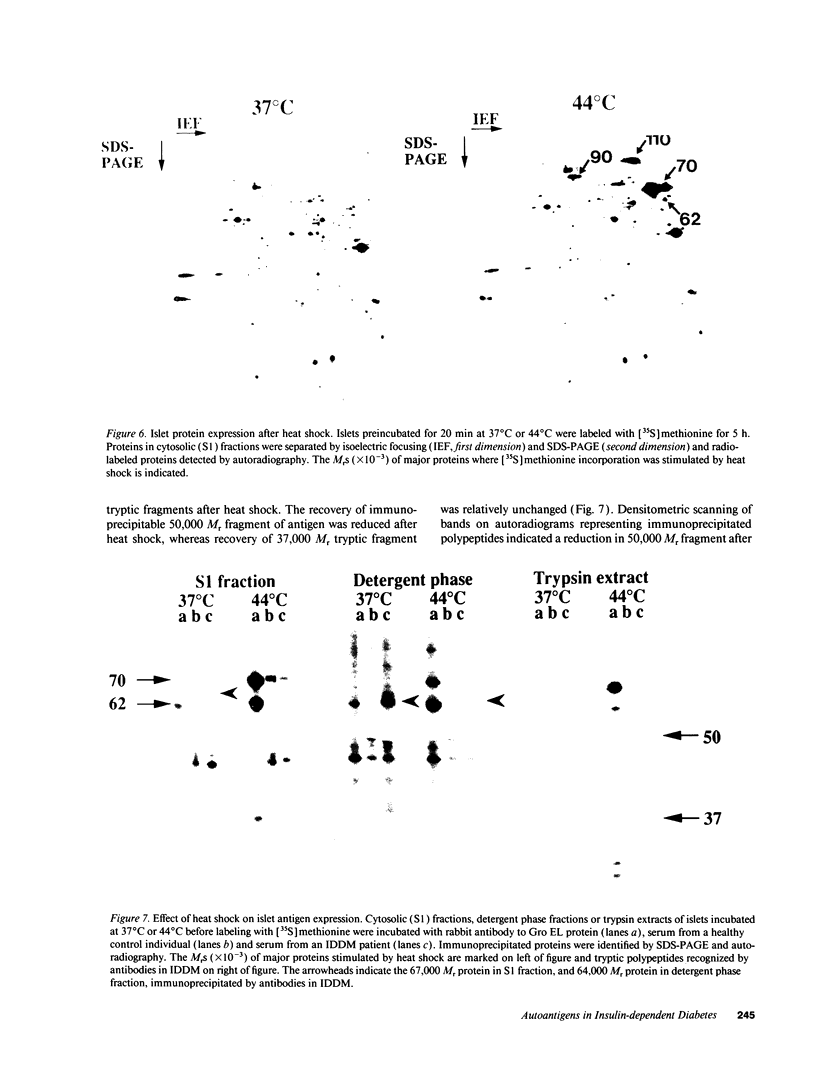
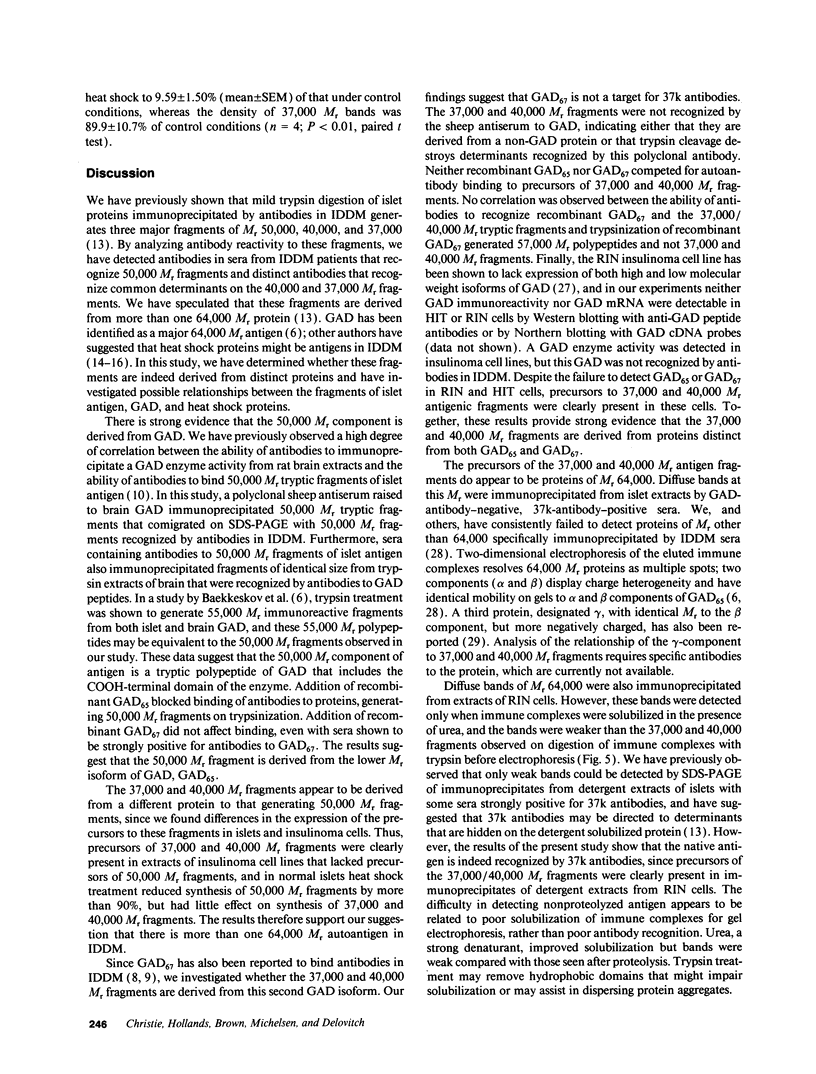
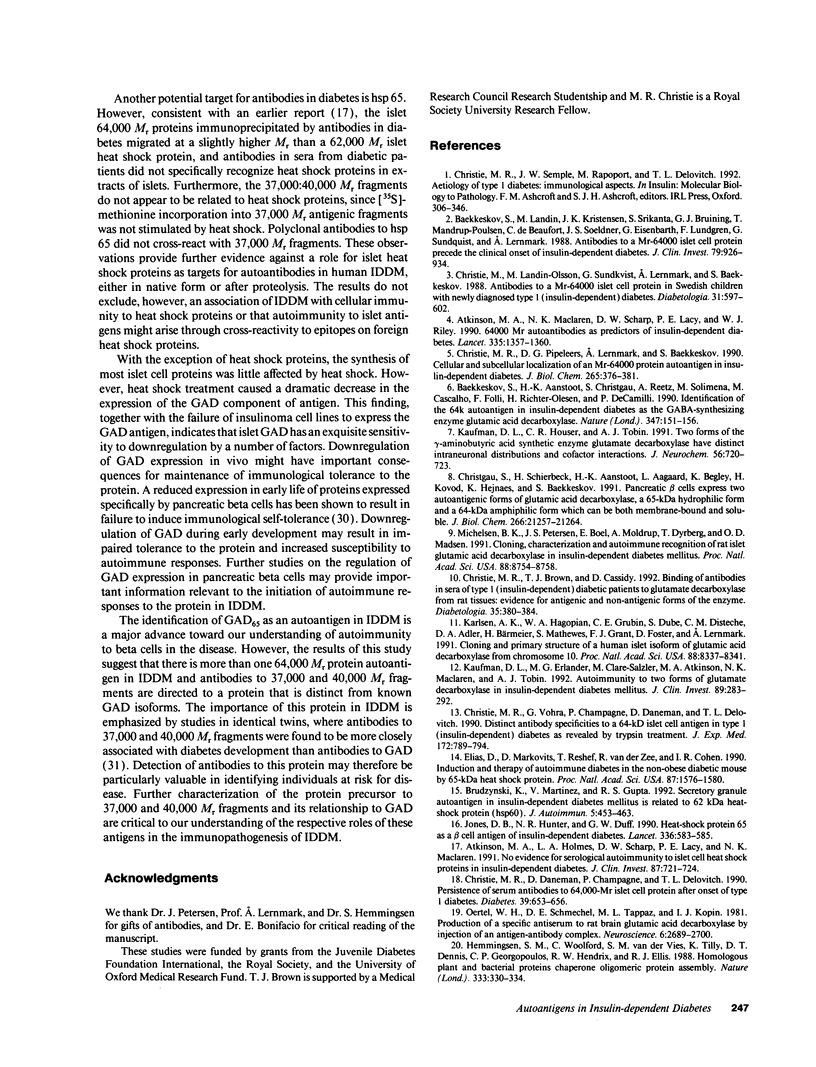
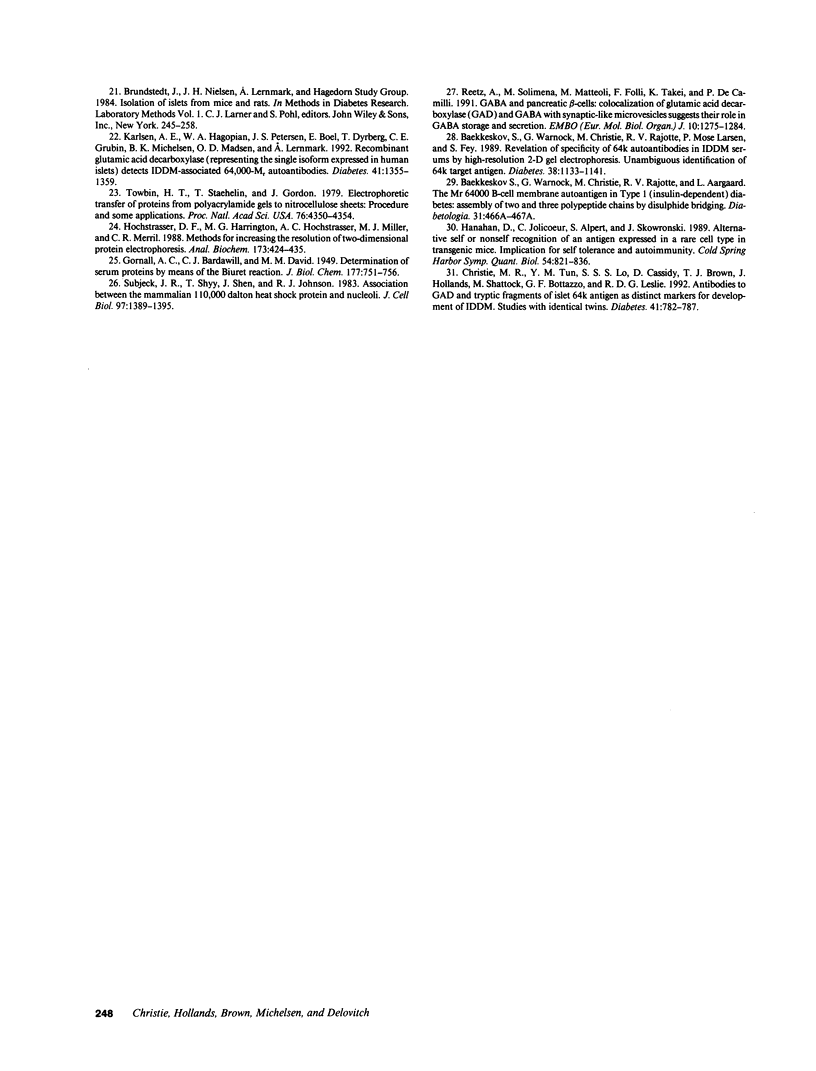
Images in this article
Selected References
These references are in PubMed. This may not be the complete list of references from this article.
- Atkinson M. A., Holmes L. A., Scharp D. W., Lacy P. E., Maclaren N. K. No evidence for serological autoimmunity to islet cell heat shock proteins in insulin dependent diabetes. J Clin Invest. 1991 Feb;87(2):721–724. doi: 10.1172/JCI115051. [DOI] [PMC free article] [PubMed] [Google Scholar]
- Atkinson M. A., Maclaren N. K., Scharp D. W., Lacy P. E., Riley W. J. 64,000 Mr autoantibodies as predictors of insulin-dependent diabetes. Lancet. 1990 Jun 9;335(8702):1357–1360. doi: 10.1016/0140-6736(90)91241-2. [DOI] [PubMed] [Google Scholar]
- Baekkeskov S., Aanstoot H. J., Christgau S., Reetz A., Solimena M., Cascalho M., Folli F., Richter-Olesen H., De Camilli P., Camilli P. D. Identification of the 64K autoantigen in insulin-dependent diabetes as the GABA-synthesizing enzyme glutamic acid decarboxylase. Nature. 1990 Sep 13;347(6289):151–156. doi: 10.1038/347151a0. [DOI] [PubMed] [Google Scholar]
- Baekkeskov S., Landin M., Kristensen J. K., Srikanta S., Bruining G. J., Mandrup-Poulsen T., de Beaufort C., Soeldner J. S., Eisenbarth G., Lindgren F. Antibodies to a 64,000 Mr human islet cell antigen precede the clinical onset of insulin-dependent diabetes. J Clin Invest. 1987 Mar;79(3):926–934. doi: 10.1172/JCI112903. [DOI] [PMC free article] [PubMed] [Google Scholar]
- Baekkeskov S., Warnock G., Christie M., Rajotte R. V., Larsen P. M., Fey S. Revelation of specificity of 64K autoantibodies in IDDM serums by high-resolution 2-D gel electrophoresis. Unambiguous identification of 64K target antigen. Diabetes. 1989 Sep;38(9):1133–1141. doi: 10.2337/diab.38.9.1133. [DOI] [PubMed] [Google Scholar]
- Brudzynski K., Martinez V., Gupta R. S. Secretory granule autoantigen in insulin-dependent diabetes mellitus is related to 62 kDa heat-shock protein (hsp60). J Autoimmun. 1992 Aug;5(4):453–463. doi: 10.1016/0896-8411(92)90005-b. [DOI] [PubMed] [Google Scholar]
- Christgau S., Schierbeck H., Aanstoot H. J., Aagaard L., Begley K., Kofod H., Hejnaes K., Baekkeskov S. Pancreatic beta cells express two autoantigenic forms of glutamic acid decarboxylase, a 65-kDa hydrophilic form and a 64-kDa amphiphilic form which can be both membrane-bound and soluble. J Biol Chem. 1991 Nov 5;266(31):21257–21264. [PubMed] [Google Scholar]
- Christie M. R., Brown T. J., Cassidy D. Binding of antibodies in sera from Type 1 (insulin-dependent) diabetic patients to glutamate decarboxylase from rat tissues. Evidence for antigenic and non-antigenic forms of the enzyme. Diabetologia. 1992 Apr;35(4):380–384. doi: 10.1007/BF00401206. [DOI] [PubMed] [Google Scholar]
- Christie M. R., Daneman D., Champagne P., Delovitch T. L. Persistence of serum antibodies to 64,000-Mr islet cell protein after onset of type I diabetes. Diabetes. 1990 Jun;39(6):653–656. doi: 10.2337/diab.39.6.653. [DOI] [PubMed] [Google Scholar]
- Christie M. R., Pipeleers D. G., Lernmark A., Baekkeskov S. Cellular and subcellular localization of an Mr 64,000 protein autoantigen in insulin-dependent diabetes. J Biol Chem. 1990 Jan 5;265(1):376–381. [PubMed] [Google Scholar]
- Christie M. R., Tun R. Y., Lo S. S., Cassidy D., Brown T. J., Hollands J., Shattock M., Bottazzo G. F., Leslie R. D. Antibodies to GAD and tryptic fragments of islet 64K antigen as distinct markers for development of IDDM. Studies with identical twins. Diabetes. 1992 Jul;41(7):782–787. doi: 10.2337/diab.41.7.782. [DOI] [PubMed] [Google Scholar]
- Christie M. R., Vohra G., Champagne P., Daneman D., Delovitch T. L. Distinct antibody specificities to a 64-kD islet cell antigen in type 1 diabetes as revealed by trypsin treatment. J Exp Med. 1990 Sep 1;172(3):789–794. doi: 10.1084/jem.172.3.789. [DOI] [PMC free article] [PubMed] [Google Scholar]
- Christie M., Landin-Olsson M., Sundkvist G., Dahlquist G., Lernmark A., Baekkeskov S. Antibodies to a Mr-64,000 islet cell protein in Swedish children with newly diagnosed type 1 (insulin-dependent) diabetes. Diabetologia. 1988 Aug;31(8):597–602. doi: 10.1007/BF00264766. [DOI] [PubMed] [Google Scholar]
- Elias D., Markovits D., Reshef T., van der Zee R., Cohen I. R. Induction and therapy of autoimmune diabetes in the non-obese diabetic (NOD/Lt) mouse by a 65-kDa heat shock protein. Proc Natl Acad Sci U S A. 1990 Feb;87(4):1576–1580. doi: 10.1073/pnas.87.4.1576. [DOI] [PMC free article] [PubMed] [Google Scholar]
- Hanahan D., Jolicoeur C., Alpert S., Skowronski J. Alternative self or nonself recognition of an antigen expressed in a rare cell type in transgenic mice: implications for self-tolerance and autoimmunity. Cold Spring Harb Symp Quant Biol. 1989;54(Pt 2):821–835. doi: 10.1101/sqb.1989.054.01.096. [DOI] [PubMed] [Google Scholar]
- Hemmingsen S. M., Woolford C., van der Vies S. M., Tilly K., Dennis D. T., Georgopoulos C. P., Hendrix R. W., Ellis R. J. Homologous plant and bacterial proteins chaperone oligomeric protein assembly. Nature. 1988 May 26;333(6171):330–334. doi: 10.1038/333330a0. [DOI] [PubMed] [Google Scholar]
- Hochstrasser D. F., Harrington M. G., Hochstrasser A. C., Miller M. J., Merril C. R. Methods for increasing the resolution of two-dimensional protein electrophoresis. Anal Biochem. 1988 Sep;173(2):424–435. doi: 10.1016/0003-2697(88)90209-6. [DOI] [PubMed] [Google Scholar]
- Jones D. B., Hunter N. R., Duff G. W. Heat-shock protein 65 as a beta cell antigen of insulin-dependent diabetes. Lancet. 1990 Sep 8;336(8715):583–585. doi: 10.1016/0140-6736(90)93390-b. [DOI] [PubMed] [Google Scholar]
- Karlsen A. E., Hagopian W. A., Grubin C. E., Dube S., Disteche C. M., Adler D. A., Bärmeier H., Mathewes S., Grant F. J., Foster D. Cloning and primary structure of a human islet isoform of glutamic acid decarboxylase from chromosome 10. Proc Natl Acad Sci U S A. 1991 Oct 1;88(19):8337–8341. doi: 10.1073/pnas.88.19.8337. [DOI] [PMC free article] [PubMed] [Google Scholar]
- Karlsen A. E., Hagopian W. A., Petersen J. S., Boel E., Dyrberg T., Grubin C. E., Michelsen B. K., Madsen O. D., Lernmark A. Recombinant glutamic acid decarboxylase (representing the single isoform expressed in human islets) detects IDDM-associated 64,000-M(r) autoantibodies. Diabetes. 1992 Oct;41(10):1355–1359. doi: 10.2337/diab.41.10.1355. [DOI] [PubMed] [Google Scholar]
- Kaufman D. L., Erlander M. G., Clare-Salzler M., Atkinson M. A., Maclaren N. K., Tobin A. J. Autoimmunity to two forms of glutamate decarboxylase in insulin-dependent diabetes mellitus. J Clin Invest. 1992 Jan;89(1):283–292. doi: 10.1172/JCI115573. [DOI] [PMC free article] [PubMed] [Google Scholar]
- Kaufman D. L., Houser C. R., Tobin A. J. Two forms of the gamma-aminobutyric acid synthetic enzyme glutamate decarboxylase have distinct intraneuronal distributions and cofactor interactions. J Neurochem. 1991 Feb;56(2):720–723. doi: 10.1111/j.1471-4159.1991.tb08211.x. [DOI] [PMC free article] [PubMed] [Google Scholar]
- Michelsen B. K., Petersen J. S., Boel E., Møldrup A., Dyrberg T., Madsen O. D. Cloning, characterization, and autoimmune recognition of rat islet glutamic acid decarboxylase in insulin-dependent diabetes mellitus. Proc Natl Acad Sci U S A. 1991 Oct 1;88(19):8754–8758. doi: 10.1073/pnas.88.19.8754. [DOI] [PMC free article] [PubMed] [Google Scholar]
- Oertel W. H., Schmechel D. E., Tappaz M. L., Kopin I. J. Production of a specific antiserum to rat brain glutamic acid decarboxylase by injection of an antigen-antibody complex. Neuroscience. 1981;6(12):2689–2700. doi: 10.1016/0306-4522(81)90113-5. [DOI] [PubMed] [Google Scholar]
- Reetz A., Solimena M., Matteoli M., Folli F., Takei K., De Camilli P. GABA and pancreatic beta-cells: colocalization of glutamic acid decarboxylase (GAD) and GABA with synaptic-like microvesicles suggests their role in GABA storage and secretion. EMBO J. 1991 May;10(5):1275–1284. doi: 10.1002/j.1460-2075.1991.tb08069.x. [DOI] [PMC free article] [PubMed] [Google Scholar]
- Subjeck J. R., Shyy T., Shen J., Johnson R. J. Association between the mammalian 110,000-dalton heat-shock protein and nucleoli. J Cell Biol. 1983 Nov;97(5 Pt 1):1389–1395. doi: 10.1083/jcb.97.5.1389. [DOI] [PMC free article] [PubMed] [Google Scholar]
- Towbin H., Staehelin T., Gordon J. Electrophoretic transfer of proteins from polyacrylamide gels to nitrocellulose sheets: procedure and some applications. Proc Natl Acad Sci U S A. 1979 Sep;76(9):4350–4354. doi: 10.1073/pnas.76.9.4350. [DOI] [PMC free article] [PubMed] [Google Scholar]



